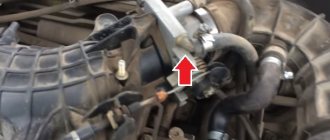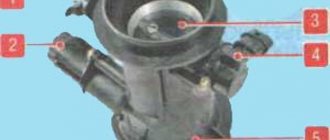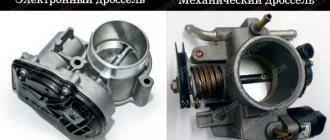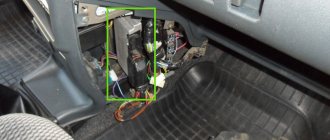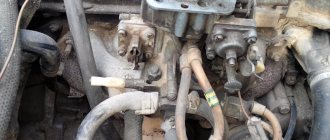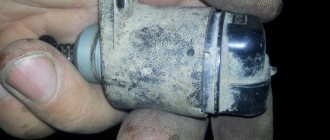Throttle body 56mm
The most common question asked by Nivovody and Shnivovody is: how to make tuning cheaper and make the car perform like an adult.
If I don’t know of any other scenario for a carb car besides a low-level camshaft, then one wonderful detail has appeared for an injection car. This is a larger diameter throttle valve. I won’t say that 10 horses will be added at once, but you will feel the effect with a fully serviceable engine. I sometimes hear the opinion that I express my impressions of spare parts subjectively, that is, without numbers, graphs and tables. The fact is that I just want to convey information in a simpler way, knowing that I have higher education and practical work in this area, and people (in the vast majority of cases) have their own work and education in completely different areas in which they are specialists. Today I’ll try to provide numbers and comparative data. First, a little theory: the more air, the more gasoline will be injected. And the Throttle is the narrowest place in the air tract, of course up to the intake manifold. The standard damper has a minimum internal diameter of 46 mm, in this case the cross-section is increased to 54 mm. This product is made from a standard shutter, boring and installing a new shutter and axle. The data on my car before installation is as follows: air consumption at XX 14 kg, at 3000 rpm. about 22 kg. After installing a new throttle valve, at XX all the numbers remained the same (the idle speed path was not changed one bit), but the air consumption at 3000 became 33 kg. In general, this gives an increase in power somewhere from 2500-3000 rpm. This is mainly felt very strongly on the highway, to a lesser extent in the city. I liked the phrase that Borya-Bobs said after installing this product. On the Yukkovskaya highway, where you constantly pull the handle between 3-4, I was driving at 4 as if on cruise control, regulating the movement only with the gas pedal. Since this product has standard fasteners, replacement takes 20 minutes. Now about the statistics, to test how this thing affected fuel consumption, I took about 10 cars from my work and asked the driver to measure the consumption for the same driving style and preferably in the same modes. At the end of the experiment, people said that of course, with this damper, they no longer wanted to move in the same mode, but we tried. The average indicators are as follows: average consumption dropped by 450-500 g. It’s not much, but a little bit here, a little bit there……as a result we get the result. And of course, the good old truth that was drummed into me in my tank design bureau: on the same vehicle, the higher the engine power, the lower the fuel consumption and the longer its resource. Of course, the change in the dynamics of the car is quite noticeable when there is a German air flow meter. I have already said many times that both are labeled Bosch. But with the inscription “made in Germany” it measures the air flow plus or minus a thimble, and with the inscription “made in Russia” plus or minus a bucket.
Frequently asked question : is the throttle valve of the 2112 and our 21214 engines the same or not? The flaps are different. When installing the damper from the “two-wheeler”, incorrect engine operation occurs at idle.
Important: during self-installation, the question is often asked why, during the first starts, the XX speed suddenly “stuck” at 1200-1500 rpm. The engine and brains don’t see the new damper, but the IAC requires adaptation. It's different on different brains. For example: for Bosch 7.9.7 you need to turn the ignition to the first position - turn it off - and after that start the car. For others, start the car and rev it up several times, turn it off and start it again. The specifics depend on the ECU and firmware. Diagnosticians know this, but in the case of self-installation, you will have to either surf the Internet or go through the “experience.”
Addition from 2013. The dampers are sold with a diameter of 56 mm. It is advisable to update the brain to Euro-2 in order to at least disable the second lambda probe. I repeat separately, for those “lucky” people with an electronic gas pedal, this product is not suitable for you.
Temperature sensors used
The sensors used are classified into two types:
According to the purpose of use they are divided into 3 types:
- temperature indicator sensor;
- outside air temperature;
- liquid cooling temperature.
The first type (with a negative temperature coefficient) is most often used. If desired, you can install two structures at once: one as the main one, the other as an additional one.
The main component of the coolant sensor design is the thermistor. According to the principle of operation, this is a resistor that changes its resistance depending on the ambient temperature. It is protected by a metal case, on the surface of which cutters are applied. They are connected to the tail section, mounted from plastic. This is where the contacts that connect to the wiring are located. One contact is positive (comes from the electronic unit); the other is negative (connected to ground).
The principle of operation is that a constant voltage flow of 5 V is supplied to the thermistor from the electronic unit. As the temperature increases or decreases (depending on the type of sensor used), the resistance of the thermistor decreases, and the voltage across it decreases accordingly. As a result, when this voltage hits, the car’s electrical unit calculates the temperature of the engine and displays the desired indicator on the dashboard.
Throttle valve NIVA
Removing the throttle assembly in Niva
We remove the throttle assembly to replace the idle air control or throttle assembly gasket. Disconnect the negative wire from the battery. Partially drain the coolant.
Use a Phillips screwdriver to loosen the clamp securing the air hose to the throttle body
1:1415
Disconnect the air hose.
1:1494
1:1572
and remove the crankcase ventilation hose from the throttle body fitting.
Use pliers to loosen the clamps
4:1302
4:1328
and remove the coolant inlet and outlet hoses from the throttle body fittings.
4:1502
4:1554
remove the adsorber hose from the fitting.
Disconnect the throttle position sensor and idle air control connectors.
Disconnect the cable from the damper drive pulley
7:1441
Using a 13mm socket with an extension, unscrew the two nuts securing the throttle assembly to the receiver.
7:1638
Remove the throttle assembly.
The connection is sealed with a gasket.
The air flow in the receiver is organized by a plastic sleeve.
10:1348
The flat on the bushing should face the flat surface of the receiver.
10:1500
Install the throttle assembly in reverse order. The tightening torque of the nuts is 15–20 N.m. Add coolant.
Cleaning the throttle valve in NIVA
A problem in the Niva: periodic freezing of the idle speed in the region of 1200 - 2000 revolutions (when restarting the car they show the norm, so the cable has nothing to do with it) I came to the conclusion that I need to clean the IAC, but in order to remove it I need to remove the throttle. No sooner said than done, remove the throttle, take carburetor flushing fluid (thanks to a friend), cotton swabs and a piece of cloth, maybe a toothbrush. And also the throttle valve gasket, since the old one can break, as happened to me. (costs 25 rubles) We removed it and we see the throttle is dirty, but I’m not really worried about the oily coating on it and inside the receiver on the inside the throttle is clean.
We cleaned the throttle and IAC (I forgot to take a photo of it, but it wasn’t particularly dirty), something like the following should happen.
I decided to abandon the “hyper virginity” in the receiver; it’s not a necessary thing, and it could have negative consequences
We put everything together in the reverse order and go for a test drive. I drove about 70 km, the idle speed was normal, when I drove up to the house it was 2000 thousand again, we’ll continue to drip, from what we did it definitely won’t be worse, at least there was throttle response and an instant response to gas pedal. The next thing will be to check for a glitch of the air flow sensor (I’ll see how much the damper is open in % at idle if 0 I’ll dig further) check the mass air flow sensor while driving without it (I will disconnect the connector), and if there is no result, I will turn off the IAC the car will keep the speed at idle in the region of 1000 revolutions (the mass air flow sensor takes over its work; I’ll look at the increase in speed)
Oh yes, there’s no need to write about diagnostics. The book doesn’t give errors, the “check” doesn’t light up, and I can do the diagnostics myself.
Replacing the throttle position sensor for NIVA
Since the glitch did not go away by cleaning the throttle and the XX regulator, I decided to move on and, in order not to randomly change the sensors, I decided to calculate what was changing in the Injector parameters. When a glitch appeared, I did find a change; it was like the throttle valve was open by 1%, but since I know for sure that it is closed and the cable does not bite the damper and does not jam (since after you restart the car the speed is normal, which means there is something electronic here, not mechanical) And only the TPS shows the opening of the damper, so we will change it. I bought the TPS The next day I went to remove the remote control (throttle assembly) and unscrew the screw with pliers. To remove the remote control you will need a Phillips screwdriver and a small ratchet with an extension and a 13 socket. You need to unscrew the next 5 clamps and remove the cable holder bracket with pliers or a screwdriver
another clamp below
two nuts 13 diagonally
2 sensor connectors, upper TPS, lower IAC and remove the remote control
The remote control is still clean after 3 days of cleaning
and here are the two heroes of the occasion, TPDZ and SCREW, unscrew the screw with pliers
two TPS: on the left – old, on the right – new
snail inside without a “intact”, it was removed last time
new sensor in place
The car didn’t start right away, but the second time it started and stalled for the first time, as soon as it started up a second time there was a sound as if something iron had got into the “snail” and there it flies around from the air flow and hits the walls of the cochlea, but it turns out everything is much simpler I forgot to put on the crankcase ventilation hose, so I drove the car at XX throttle and nothing came out. The problem is gone.
https://www.autoprospect.ru/vaz/21213-niva/5-2-12-snyatie-drosselnogo-uzla.html, https://www.drive2.ru/l/2287912/, https://www .drive2.ru/l/2305631/
Spark plugs NIVA
Spark plugs: review, service life, examination BOSCH Platinum plus spark plugs at NIVU Revision
Removing (replacing) the throttle assembly
We remove the throttle assembly to replace the assembly itself, the idle air regulator or the throttle assembly gasket, as well as to clean the throttle valve from dirt.
throttle assembly
Disconnect the negative cable from the battery.
Partially drain the coolant (see here). (with known skill, you can avoid draining the liquid by plugging the hoses with suitable plugs immediately after disconnecting them)
Use a Phillips screwdriver to loosen the clamp securing the air hose to the throttle body.
Disconnect the air hose.
. and remove the crankcase ventilation hose from the throttle body fitting.
Use pliers to loosen the clamps.
. and remove the coolant inlet and outlet hoses from the throttle body fittings.
. remove the adsorber hose from the fitting.
Design
The damper is a rotary disc valve on a horizontal axis, which is opened by tensioning the cable from the control (gas) pedal. It returns to the closed position under the action of a spiral spring. The drive cable is attached to a sector lever mounted on the rotary valve axis. The aluminum alloy housing contains an air diffuser that houses the damper mechanism. In addition, channels for coolant are cast in the body, for the passage of air at idle, crankcase ventilation, purging the adsorber and supplying vacuum to the vacuum brake booster.
The idle speed control and throttle position sensor are installed on the housing and are electrically connected to the engine ECU. The throttle body is attached to the intake manifold on two threaded rods through a gasket.
To connect hoses, all channels of the housing have fittings (nozzles).
Principle of operation
The air consumed by the engine during operation passes through the air filter and moves through the air duct to the intake manifold. In the throttle body diffuser, which has a smaller cross-section than the air duct, the flow rate increases significantly. Even with the valve fully open, the throttle assembly has a large aerodynamic resistance (AC) to the air flow. The value of AC is proportional to the square of the flow velocity.
As a result, the volume of air entering the intake manifold per unit time is equal to the cross-sectional area of the diffuser multiplied by the flow velocity to the second power and by the AC coefficient.
Additionally, air flow is affected by atmospheric pressure, temperature and humidity.
The throttle position sensor determines the angle of rotation and the degree of opening, and transmits this data to the ECU. The ECM program, taking into account information from other sources, including the mass air flow and temperature sensors, controls the injectors that supply exactly as much fuel as is required at a given moment.
On a new car, with a clean air filter and an unworn piston, everything works perfectly. Air and gasoline are mixed in the correct proportions, the amount of mixture burned depends only on the crankshaft speed. Power, a derivative of the number of revolutions and torque, pleases the soul of the owner.
Features of operation
The manufacturer equips the Chevrolet Niva engine with a throttle body with a 46 mm diffuser.
The control program and all sensors that monitor the parameters of a running engine work correctly only with the “native” unit.
Some car users, hoping to increase engine power by adding air, install a unit with a diffuser of increased diameter - 52, 54 and even 58 mm. Of course, the aerodynamic resistance of the air path as a whole is reduced, but the consumed amount of air remains unchanged and is almost equal to the volume passing through the stock diffuser.
The throttle valve is not a turbocharger; supplying air to the cylinders at high pressure is not its function.
An increase in the transverse size of the damper diffuser reduces the aerodynamic resistance of the air path as a whole, but the resulting increase in power and changes in other engine parameters can only be determined in laboratory conditions, using instruments. The only thing that the car user will feel is that the engine (without load!) began to respond more quickly to pressing the gas pedal.
When replacing the damper with a larger one, you must definitely change the parameters in the car’s firmware (reflash).
A completely different situation arises if the engine has undergone tuning, with an increase in cylinder diameter, piston stroke and a change in valve timing (block boring, different crankshaft and camshaft). In this case, specialists who have made a “sports” engine out of a standard engine must know in advance - or calculate - the required cross-section of the throttle unit diffuser (changes also need to be made to the program of the ECU unit).
Even after repairs with replacement of the piston, it is recommended to install a unit with a flow area of no more than 52 mm on a typical engine.
During operation, any engine wears out. Through the increased gaps between the piston rings and the cylinder walls, gases from the combustion chamber begin to penetrate into the crankcase and, together with the oil mist in the crankcase, enter the idle channel through the crankcase ventilation system. The possibilities of the air filter are not limitless; dust particles less than 0.5 microns in size pass through any “sieve”. The smallest particles of carbon deposits, dust and oil, meeting in the throttle body, turn into low-temperature sludge and settle on surrounding surfaces.
As a result: the resistance of a dirty diffuser increases, the damper overgrown with “moss” prevents air movement. The crankcase ventilation pipe, idle air control valve and its channel are clogged with dirt.
The design of the throttle valve mechanism is simple, virtually wear-resistant and very durable. Only internal contamination can disrupt its normal operation.
Operating principle and device
The device is an air valve, the position of which changes when the gas pedal is moved. The throttle assembly includes several parts:
- Frame.
- Remote control position sensor, which reads information about its position and transmits it to the engine ECU.
- The idle channel through which air enters the manifold when the gas pedal is released.
- Canister purge hose fitting.
- Idle speed regulator, which changes the air flow when the throttle body is closed.
- A throttle valve that directly regulates air flow and pressure in the manifold.
- Crankcase ventilation hose fitting.
- Remote control drive, including an axis, spring and other elements.
- Heating unit fittings (heating is carried out by coolant).
The throttle body is attached to the intake manifold. A gasket is used to seal the joint.
The node works as follows:
- When you move the gas pedal, the damper rotates on its axis and opens air access.
- The pressure in the manifold increases, causing more fuel-air mixture to enter the cylinders.
- Engine power and fuel consumption increase.
A closed air valve creates a vacuum in the intake manifold. It is used to drive the brake booster and purge the adsorber that filters gasoline vapors.
How to check TPS?
To diagnose the throttle position sensor, you will need a multimeter or scanner that reads the on-board computer.
The test consists of monitoring the voltage at different throttle positions. To do this you need:
- Disconnect the wires from the sensor connector.
- Turn on the ignition.
- Connect a multimeter in voltmeter mode to the contacts.
Tip: you can find out the functionality without measuring instruments in a simple way - install a known working part from another car. If the symptoms disappear, the problem is in the sensor.
When the accelerator pedal is released, the device should show 0.7, and when pressed all the way - 4 volts. You also need to make sure that when you smoothly change the position of the accelerator pedal, the voltage changes smoothly.
If the multimeter readings do not correspond to the nominal values or change abruptly when the damper position is gradually changed, the part needs to be replaced.
What does the bore diameter affect?
The amount of air-fuel mixture that enters the cylinders determines the power of the engine. It depends on two factors:
- Valve opening degree - from 0 to 100%.
- Cross-section of the passage hole.
The first indicator depends on the position of the gas pedal, and the second on the design of the throttle assembly.
The factory equipment of the Chevrolet Niva provides for the installation of a damper with a diameter of 46 mm.
To increase the air supply and engine power, car owners install diaphragms with a large diameter - from 52 to 58 mm.
Important: engine power does not increase in proportion to the valve diameter. The amount of fuel-air mixture depends on the working volume of the cylinders. The standard size of the passage opening is sufficient to fill the combustion chamber. Increasing the valve diameter cannot radically change the characteristics of the motor.
The maximum size of the tuning damper that should be installed on a standard Chevrolet Niva engine is 54 mm. A larger diameter (56 mm) is needed only for sports versions of cars with an increased engine capacity.
Increasing the throttle flow area without modifying the engine only gives the illusion of an increase in power. The response to pressing the gas pedal becomes sharper.
For example, if you lightly press the gas, the standard throttle will open 10%, and the extended throttle will open 15-20%. At the same time, the maximum power and throttle response remain virtually unchanged. In order for the combustion chambers to be completely filled with the fuel-air mixture, you do not have to press the pedal all the way.
It happens that after installing an increased emergency protection, the standard engine actually becomes more powerful. This has a simple explanation: instead of the old clogged damper, a new clean one is installed. The same effect can be achieved by a simple and cheap method: remove and wash the throttle assembly.
Advice: it makes sense to install an enlarged throttle after boring the cylinders and installing a sports camshaft, which changes the valve timing.
Chevrolet Niva › Logbook › Cleaning the throttle and crankcase ventilation + various little things, 68,690 km.
All the best! The car doesn't let you get bored. 1. Oil consumption is observed in the engine. Since the replacement (about 3500 km ago) I have added about 200 ml. Engine above 3-3.5 thousand rpm. I'm not twisting. Now filled with ZIC X9 FE 5W-30. I don’t see any point in sinning with this oil yet. This is not the first time it has been poured into other cars and there have never been problems with its consumption. There are no obvious leaks on the motor. I decided to start with preventive measures. I removed and washed the throttle valve (there is this one, art. 2123-1148010), the idle air valve (it costs this one, 21203-1148300-03), the receiver, the engine breather, replacing the large one (art. 2123-1014240) and the small one (art. 2123- 1014056) pipes. At the same time, replace the breather cover gasket (art. 2101-1014215), the receiver gasket (art. 2123-1008055-01), the receiver gasket on the stud (art. 2123-1008033), the throttle valve gasket (art. 2112-1148015). Actually, the main dirt was on the idle air valve. The rest of the parts are more or less clean. After assembly, starting the first time, the idle speed became even more stable (previously, judging by the BC readings, the speed stayed at 800-840, now it very rarely drops to 800, mostly staying at 840 rpm). The engine response remained at the same level. 2. The valve in the expansion tank cap is stuck again. I assembled one from three lids. I took the insides from a cover produced by “Avtopribor” (art. 2108-1311065-01). I noticed that the three holes on the Autodevice cover for air outlet from the tank have a diameter of 3.5 mm. On all other covers 1.5-2 mm. As a result, I adjusted the plug to a pressure of 0.5 kgf/sq.cm. In order to avoid problems with the plug, there are thoughts of switching to a tank from Renault Logan (analog, Meyle tank with a lid, art. 16142230000, 847 rubles, not such a big expense). 3. Regarding HBO. The system works, everything is fine, I like everything. Consumption on the highway is 11.5 liters in the city - about 13 liters. Strange, but less than with gasoline. The only thing is that the idle speed sometimes fluctuates. Moreover, when running on gasoline, there are no problems with idling. One of these days I will go to the HBO installers. I’ll update the post based on the results. For convenience, I moved the HBO button to the damper control panel.
Update dated March 16, 2021. I went to the gas equipment installers. Connected a computer with software. The HBO training period (after installing the equipment you need to drive 100 km on gasoline) went well. We slightly adjusted the map manually and the idle speed is now normal at 840, sometimes 880 rpm. Good luck on the roads!
Source
Symptoms of a malfunction and how to fix them
The throttle valve mechanism has a high safety margin and is almost not subject to wear. Problems arise due to contamination of the unit. Atmospheric air, which passes through the throttle in large volumes, is cleaned by an air filter.
However, tiny particles of dust remain in it, which settle on the parts of the mechanism. The process is aggravated by small splashes of oil that penetrate along with crankcase gases.
A coating forms on the walls and damper, which prevents the damper from closing completely or interferes with its smooth operation. Clogged channels of the unit create air resistance, as a result of which engine power decreases.
Signs of remote control contamination:
- Unstable engine operation at low speeds.
- Jerking when driving at low gas.
- Problems starting the engine.
- Power drop.
To eliminate the problem, you need to clean the throttle valve. This can be done with a special aerosol that dissolves plaque on the inner surface of the throttle assembly.
Causes of pollution and how to deal with them
There are several reasons why the throttle body becomes dirty over time. By avoiding their appearance, you will automatically extend the time between cleaning it. Reasons mentioned include:
Clogged fuel filter
Change the air and fuel filters on time, fill with high-quality gasoline, and prevent dust from getting into the car's fresh air ventilation system. All this will save you from the need to clean the throttle valve ahead of schedule.
Cleaning
Using a special aerosol to clean the remote control without dismantling it is possible only when it is lightly soiled. Therefore, if problems arise, it is better to dismantle the throttle and remove dirt using a carburetor cleaner.
For this you will need:
- Phillips and flathead screwdrivers.
- 13mm head with extension.
- A can of cleaning product (“Carb & Choke Cleaner” or equivalent).
Attention: cleaning of the diaphragm must be performed after the engine has cooled down. Otherwise, there is a risk of getting burned by the coolant or hot parts of the engine and throttle.
To clean the throttle valve, you must perform the following steps:
- Remove the ground wire from the battery.
- Remove the plastic engine screen.
- Loosen the air duct clamp.
- Remove the air supply hose from the fitting on the throttle body.
- Loosen the clamps and remove the crankcase ventilation, coolant and adsorber pipes from the throttle pipes.
Attention: place a small container under the cooling system hoses to collect antifreeze.
- Bend the cooling system pipes upward and tie them to the hood pillar.
- Disconnect the wiring harness from the throttle position sensor (TPS).
- Disconnect the terminal from the idle speed control.
- Remove the spring clip from the drive pulley and unhook the cable.
- Unscrew the two nuts securing the throttle assembly.
- Remove the throttle.
- Unscrew the fastening screws and remove the idle speed control and TPS.
- Treat the insides of the throttle body with a cleaning agent.
Due to the fact that the liquid from the can is supplied under pressure, it effectively washes away plaque.
Reassembling the mechanism after cleaning is performed in the reverse order. Before installing the clamps, they should be lubricated with machine oil. This makes tightening easier and increases the reliability of the connection.
Removing the cable and pedal of the VAZ-21214 throttle valve
We replace the throttle drive cable if it becomes frayed or when the cable gets stuck in the sheath. We also remove the cable during various works related to removing the throttle assembly
Slide the protective silicone cap off the end of the cable sheath.
Using two 13mm wrenches, loosen the nuts securing the damper drive cable sheath to the bracket.
Unscrew the nut and remove the cable from the bracket slot
Remove the spring clip
We remove the cable tip from the damper drive pulley
In the cabin, use a screwdriver to pry up the end of the cable and remove it from the pin of the drive lever
We remove the cable sheath from the rubber bushing of the front guard.
Using a screwdriver, pry up the rubber bushing and remove it from the front panel.
We take out the throttle valve drive cable.
To remove the pedal in the cabin, use a 13mm socket to unscrew the two nuts securing the pedal bracket
Remove the pedal with bracket
Install the pedal and throttle cable in the reverse order
During assembly, we adjust the drive so that when the pedal is released and pressed, the damper is, respectively, completely closed and completely open.
How does the idle speed sensor work on a Niva 21214 injector?
The regulator, idle speed sensor Niva-21214 injector is responsible for the cold start of the engine and its operation at low speeds when the gear is off. Previously, on carburetors, these functions were performed by 2 units: an air damper with a cold start membrane and an electric valve with an idle jet.
To some extent, diagnosing malfunctions was easier than after the advent of the electronic fuel control system. Nevertheless, if you wish, you can also understand it in order to detect problems with the regulator and fix them yourself.
Element location and operating principle
In fact, the term "sensor" is not very suitable for the name of this element, since it does not measure any parameters. It is more correct to call the device the idle speed controller VAZ-21214. This is a small unit with a stepper motor built inside, to which a retractable rod is attached. At the end of the rod there is a spring-loaded valve in the form of a cone, whose task is to block the cross-section of the channel where the air moves.
As in carburetors, the operation of an engine with an injector at idle is ensured by a separate system, where the main role is played by a regulator controlled by a controller. The air supply control unit has a special channel that bypasses the throttle valve. That is, the Niva’s power unit idles with the throttle completely closed, while air enters the injector through the bypass. This is where the VAZ-21214 idle speed sensor is located; its task is to increase or decrease the air flow passing through the bypass at the command of the controller. To start a cold engine, it is always necessary to supply an enriched mixture to the cylinders, and as it warms up, gradually deplete it to normal. Previously, the issue was solved by closing the primary chamber using a damper, which caused a vacuum to arise in the manifold and the engine drew in more fuel.
Nowadays, fuel is supplied to the cylinders by injection, so when the engine starts, the algorithm for operating the fuel system is different, although the principle is the same:
This is why it is so important not to touch the accelerator pedal while starting and warming up the power unit.
By opening the throttle valve on a cold engine, you confuse the controller, which immediately tries to reduce the air flow into the manifold by closing the idle air passage through the regulator. The motor is unstable until you release the pedal.
Additional function of the regulator
An additional function of the device in question is to block the air flow in forced idle mode. This mode is activated when 3 conditions are met:
- the car is coasting;
- any gear is engaged;
- engine speed above 1800 rpm.
Under such conditions, it is impractical to supply the air-fuel mixture to the cylinders, since the car moves by inertia. So fuel will be wasted. Therefore, based on the damper and speed sensors, the controller stops the supply of fuel and air, giving the corresponding commands to the injectors and the idle speed controller. When the speed drops below 1800 rpm or the driver presses the gas pedal, the supply of the combustible mixture is resumed. If the driver switches the gearbox to the neutral position, the regulator opens the channel, and only idle speed is activated.
Replacing an element
Signs of failure of the idle speed element are very similar to the failure of the throttle position sensor, only in this case the “Check engine” display does not flash on the instrument panel. The car does not start well when cold, is unstable at idle and may stall when coasting. The regulator cannot be repaired; it only needs to be replaced.
The element is replaced in the following order:
- Disconnect all pipes from the throttle body, unscrew and remove this unit. Without this, dismantling the regulator is impossible.
- The element in the form of a barrel with a flange is screwed to the body with 2 screws. Unscrew them and pull out the regulator without losing the gasket.
- Measure the length of the rod on the new element, starting from the flange of the part; it should not exceed 23 mm. If the rod is longer, then you need to retract it, briefly applying a voltage of 12 V to the contacts marked “D” and “C”.
- Wipe the seat with a rag to remove dirt, lubricate the gasket with motor lubricant and install the new regulator in place.
After replacement, you need to install the throttle valve assembly back, connect the pipes and start the engine to check.
sensors for engine 21214
After the publication of my article on the topic of oil seals for the Niva, requests began pouring in to write the same regarding bearings and sensors for the 21214 engine, which is installed on Nivas, Niva-Ms, crocodiles and Shnivas. I’ll begin to slowly talk about “trouble-free” sensors, that is, those that you install and forget about for a very long time. A few general words. Why did this question even arise? Let me give you an example: such garbage as a throttle position sensor (TPS). Since the electronics of our injector are taken entirely from their front-wheel drive counterparts, and their number is very large, a very large number of companies make spare parts for them, and there is no need to talk about the Chinese brothers at all. For some time I even saved up faulty TPS from different manufacturers in a box, after 7 I got lost and threw everything away)) While the factory supplies only two manufacturers.
Another example is the speed sensor. When it’s burned out, it happens that when driving through a puddle, the “check engine” lights up, or the engine simply starts to stall when coasting and nothing lights up. And when you reach the service level, like a wartime exterminator, suddenly the defect disappears. This means that water got inside the case and then also leaked out. So all is well......until the next puddle. One of the most basic sensors is the mass air flow sensor (MAF) , so a separate detailed article is devoted to it.
